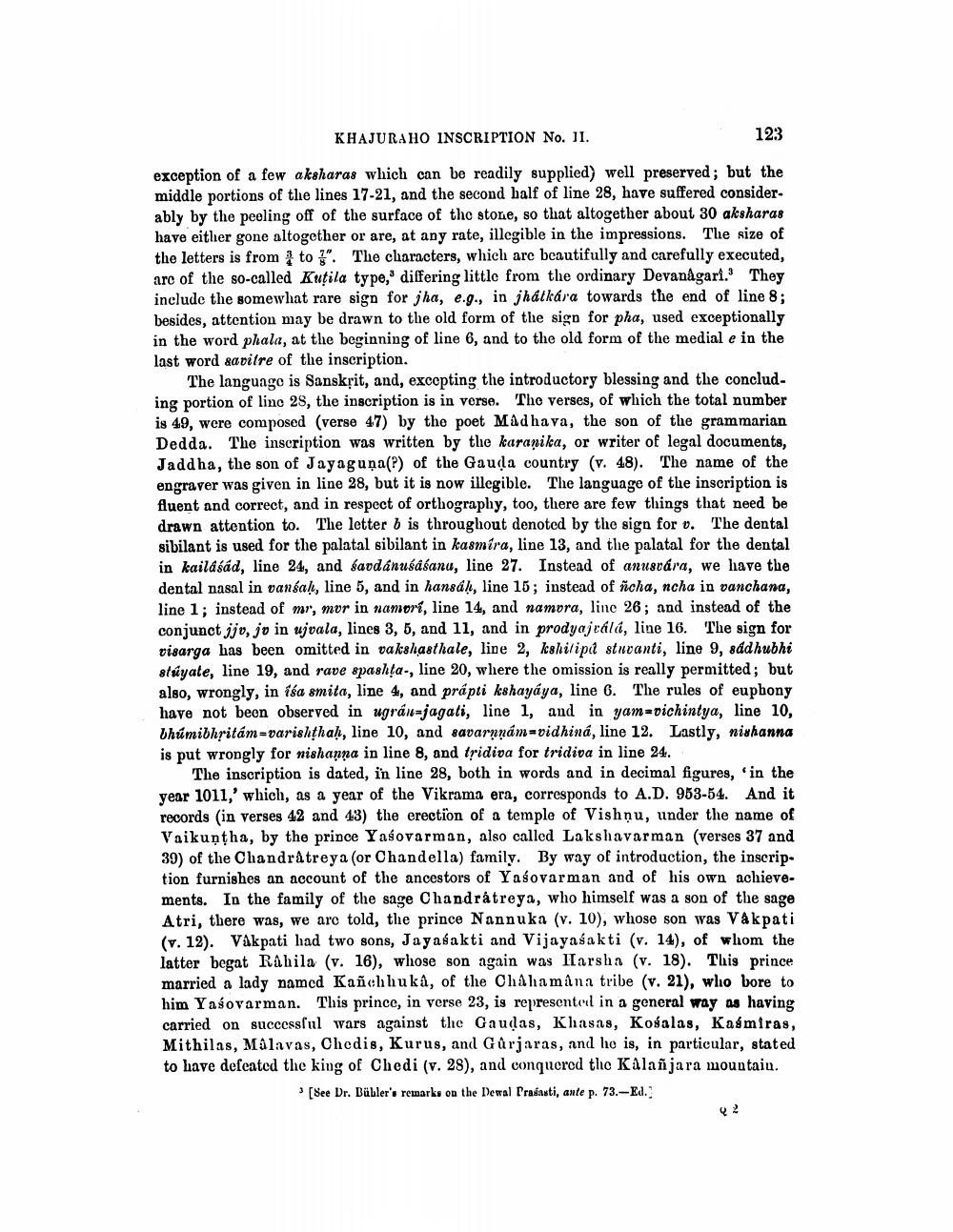________________
KHAJURAHO INSCRIPTION No. II.
123
exception of a few aksharas which can be readily supplied) well preserved; but the middle portions of the lines 17-21, and the second half of line 28, have suffered considerably by the peeling off of the surface of the stone, so that altogether about 30 aksharas have either gone altogether or are, at any rate, illegible in the impressions. The size of the letters is from to ". The characters, which are beautifully and carefully executed, arc of the so-called Kutila type,' differing little from the ordinary Devanagari. They include the somewhat rare sign for jha, e.g., in jhátkára towards the end of line 8; besides, attention may be drawn to the old form of the sign for pha, used exceptionally in the word phala, at the beginning of line 6, and to the old form of the medial e in the last word &avitre of the inscription.
The language is Sanskrit, and, excepting the introductory blessing and the concluding portion of line 28, the inscription is in verse. The verses, of which the total number is 49, were composed (verse 47) by the poet Madhava, the son of the grammarian Dedda. The inscription was written by the karanika, or writer of legal documents, Jaddha, the son of Jayaguna(t) of the Gauda country (v. 48). The name of the engraver was given in line 28, but it is now illegible. The language of the inscription is fluent and correct, and in respect of orthography, too, there are few things that need be drawn attention to. The letter 6 is throughout denoted by the sign for v. The dental sibilant is used for the palatal sibilant in kasmíra, line 13, and the palatal for the dental in kailasád, line 24, and savdanusábanu, line 27. Instead of anusvára, we have the dental nasal in vansal, line 5, and in hansáh, line 15; instead of ñcha, ncha in vanchana, line 1; instead of mr, mor in namori, line 14, and namora, line 26; and instead of the conjunct iju, jo in ujvala, lincs 3, 5, and 11, and in prodyajvald, line 16. The sign for visarga has been omitted in vakshasthale, line 2, kshilipd stuvanti, line 9, 8ddhubhi stúyate, line 19, and rave spashta-, line 20, where the omission is really permitted; but also, wrongly, in iśa smita, line 4, and prapti kshayáya, line 6. The rules of euphony have not been observed in ugrán-jagati, line 1, and in yam=pichintya, line 10, thúmibhritám=varishthah, line 10, and savarnnám=vidhina, line 12. Lastly, nishanna is put wrongly for nishanna in line 8, and tridiva for tridiva in line 24.
The inscription is dated, in line 28, both in words and in decimal figures, in the year 1011,' which, as a year of the Vikrama era, corresponds to A.D. 953-54. And it records (in verses 42 and 43) the erection of a temple of Vishņu, under the name of Vaikuntha, by the prince Yasovarman, also called Lakshavarman (verses 37 and 39) of the Chandratreya (or Chandella) family. By way of introduction, the inscription furnishes an account of the ancestors of Yasovarman and of his own achievements. In the family of the sage Chandratreya, who himself was a son of the sage Atri, there was, we are told, the prince Nannuka (v. 10), whose son was Vakpati (v. 12). Vakpati had two sons, Jayasakti and Vijayasakti (v. 14), of whom the latter begat Rahila (v. 16), whose son again was IIarsha (v. 18). This prince married a lady named Kanchhuka, of the Chahamana tribe (v. 21), who bore to him Yagovarman. This prince, in verse 23, is represented in a general way as having carried on successful wars against the Gaudas, Klasas, Košalas, Kasmiras, Mithilas, Málavas, Chodis, Kurus, and Gurjaras, and ho is, in particular, stated to have defeated the king of Chedi (v. 28), and conquered the Kalañjara mountain.
[See Dr. Büller's remarks on the Dewal Prasasti, ante p. 73.-Ed.




